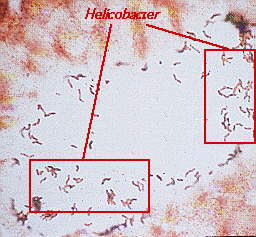
The Helicobacter genus features Gram-negative, micraerophilic organisms that are very similar to organisms of the Campylobacter genus. Both species are motile, catalase-positive, and have curved cell bodies. When you think of Helicobacter, the first thing that should come to your mind is stomach ulcers. That is because this organism is the leading cause of peptic ulcers and chronic gastritis in America. The mechanisms for pathogenesis are not well understood at this time, but the circumstantial evidence points to Helicobacter pylori as the causative agent. Infected patients can be treated with an antacid as well as tetracycline to treat the ulcers and inhibit the growth of the organism.




